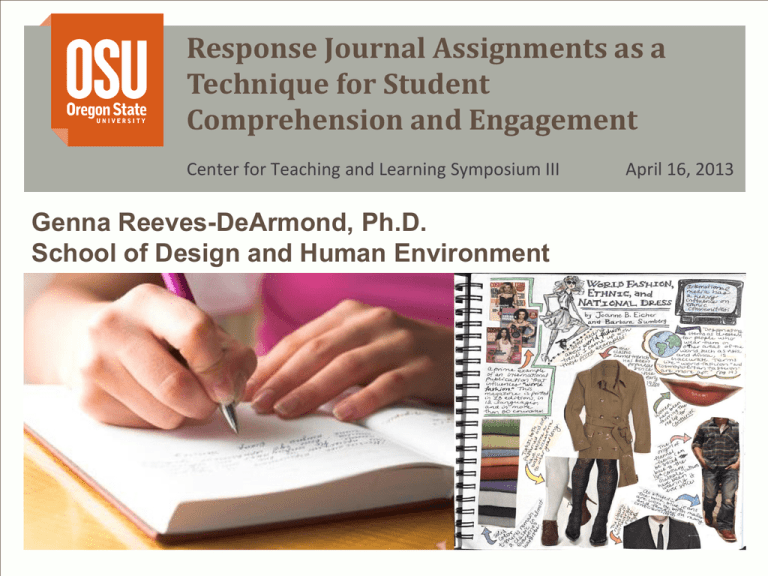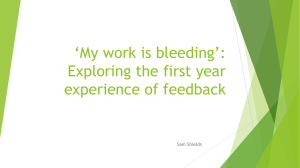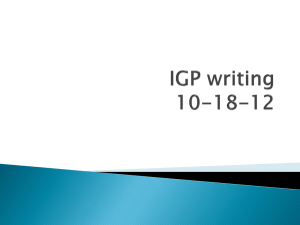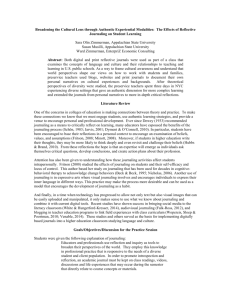Response Journal Assignments as a Technique for Student
advertisement

Response Journal Assignments as a Technique for Student Comprehension and Engagement Center for Teaching and Learning Symposium III Genna Reeves-DeArmond, Ph.D. School of Design and Human Environment April 16, 2013 The Pedagogy of Response Journals Reflective Practice and Thinking Reflective practice is the capacity to reflect on action so as to engage in a process of continuous learning. Reflective thinking helps you to recognize and clarify the important connections between what you already know and what you are learning. April 16, 2013 The Pedagogy of Response Journals Reflective Writing Response Journals Peer Review Self Assessment Diary Log Book "Writing is more than living. It is being conscious of living." -Ann Morrow Lindbergh (1965) April 16, 2013 Reflective practice is rooted in the paradigms of phenomenology and critical theory http://www.open.ac.uk/cetl-workspace/cetlcontent/documents/4bf2b48887459.pdf April 16, 2013 What is a Response Journal? Why Should I Assign a Response Journal? *Encourages active learning *Challenges students to take ownership of their learning in the course *Offers continuity and flexibility in course assignments *Challenges students to adopt new perspectives *Encourages students to further develop a variety of critical thinking functions *Provides a safe environment to express thoughts via a “trial-anderror” process -Increases confidence and comfort level with material April 16, 2013 Deciding to Use a Response Journal Assignment 1. Decide what you want the journal to be for your class. A record of responses to readings? A collection place for all class writings? Both? 2. What is the format of the journal? Informal jottings? A log? Formal short papers collected together with an introduction? 3. What is the pay off going to be for the students? That is, how will the work they put into the journal benefit them in terms of the larger class goals? 4. How do you want to incorporate the journal into class time? http://www.writing.ku.edu/~writing/instructors/guides/documents/Teaching_Journals.pdf April 16, 2013 “You Want Me to Do A Free-Writing Assignment!?”: Student Reactions of Fear and Anxiety to Journaling Students are used to being given clear parameters and thinking “inside the box.” April 16, 2013 Response journals allow students to “build the box” (i.e., individualize their learning) AND think “outside the box” (i.e., discover new perspectives and information). “You Want Me to Do A Free-Writing Assignment?!”: Getting Used to an Unstructured Assignment Developed and created by Dr. Genna Reeves-DeArmond, Oregon State University April 16, 2013 “You Want Me to Do A Free-Writing Assignment?!”: Helping Students Get Started with the Journaling Process Use of Prompts -Students receive a small amount of structure -Assists in bringing focus to the assignment http://www.busyteacherscafe.com/worksheets/bookmarks/readersresponsebookmark.pdf April 16, 2013 Helping Students Get Started with the Journaling Process: Prompt Example Developed by Dr. Genna Reeves-DeArmond, Oregon State University; Adapted from previous documents by Dr. Elaine L. Pedersen, Oregon State University April 16, 2013 Reflective Activity #1 Take out a sheet of paper and brainstorm, write down, and discuss at your table: - what course you would use a response journal in and your reasons for doing so. - possible prompts that you might use in a response journal assignment for your course/discipline. April 16, 2013 Developing Instructions for a Response Journal Assignment: My Response Journal Assignment Experience *Why choose a response journal assignment? EXAMPLE: Assignment initiated after I noticed that students were struggling with their comprehension of research articles *Response Journal Content Requirements: DEFINE CLEARLY! 1. Length (Word count, paragraphs, page, etc.) 2. What constitutes a single journal entry? 3. How many journal entries are required for each submission? 4. Format (Hand-written vs. typed, text vs. visual, pencil vs. marker/pen, etc.) 5. Required topics or up to the student? Or a mixture of both? (Required use of prompts, etc.) 6. Structure and direction: What are students responding to? April 16, 2013 EXAMPLE OF TRADITIONAL RESPONSE JOURNAL APPROACH (TYPED, FULLSENTENCES, ESSAY STYLE) April 16, 2013 EXAMPLE OF RESPONSE JOURNAL USING TABLE FORMAT (“READ AND RESPONSE FORMAT”) April 16, 2013 EXAMPLE OF DOMINANTLY -VISUAL RESPONSE JOURNAL FORMAT April 16, 2013 EXAMPLE OF RESPONSE JOURNAL USING MIND MAPPING APPROACH TO ORGANIZE IDEAS April 16, 2013 “The Students Have Turned in Their Journals…Now What?”: Response Journal Grading Practices To determine the grading criteria that will work best for you, answer the following questions: 1. 2. 3. 4. 5. 6. Do I want to use a rubric or provide qualitative comments? How many times will I collect the journals during the term? What constitutes an “A-level” entry? What constitutes a single journal entry? How many journal entries are required for each submission? What is the required length of each entry? (Word count, paragraphs, page, etc.) 7. How will I provide feedback? April 16, 2013 Assessing Students Based Upon a Semantic Grading Scale in the Rubric Developed and created by Dr. Genna Reeves-DeArmond, Oregon State University April 16, 2013 Pedagogy Meets Practice: Self-Evaluation *Refer to sample selfevaluation form handout Developed by Dr. Genna Reeves-DeArmond, Oregon State University; Adapted from previous document by Dr. Leslie Burns, Oregon State University April 16, 2013 “The Students Have Turned in Their Journals…Now What?”: Conceptual Assessment Strategy Critical Thinking Interpret the “big picture”: Justify, solve, conclude, etc. Address larger implications and make connections: Values, beliefs, etc. Reflect on the self: personal and past experiences Reflective Thinking Student: Awareness of the present BEGIN HERE Adapted from http://freepdfdb.com/pdf/reflective-writing-the-learning-centre-the-university-of-3999919.html April 16, 2013 *The goal is for students to reach the highest level; this constitutes an “A” entry This is How I Conceptualize the Movement from Reflective Thinking to Critical Thinking for My Students: *A description of each of these critical thinking functions is given to the students at the start of the term and then modeled/practiced in class. April 16, 2013 Assessing Students Based Upon a Classification System in the Rubric Self-Directed Responder (90-100%) *Refer to sample rubric handout Maturing Responder (80-89%) Emerging Responder (70-79%) Novice Responder (60-69%) Unsatisfactory Responder: Students earning below 60% need additional help http://www.docstoc.com/docs/8012379/Reading-Response-Journal-Rubric---PDF April 16, 2013 Assessing Students Based Upon a Classification System in the Rubric (see Classification System in Previous Slide) Developed and created by Dr. Genna Reeves-DeArmond, Oregon State University April 16, 2013 Reflective Activity #2 Take out a sheet of paper and, over the next three minutes, brainstorm and write down the grading criteria that you would put in place for your response journal assignment. Would you use a checklist, rubric, semantic scale, etc.? April 16, 2013 Benefit for Instructor: Simultaneously Engaged in Reflective Practice with Students Read student journals April 16, 2013 Provide feedback to students Reflect and make teaching decision Response Journal Resources April 16, 2013 Thank you for your attendance and participation! As you move forward, consider the following questions: What are the differences between response journals in the sciences and the humanities? How do we maintain the educational value of response journals across disciplines? April 16, 2013






